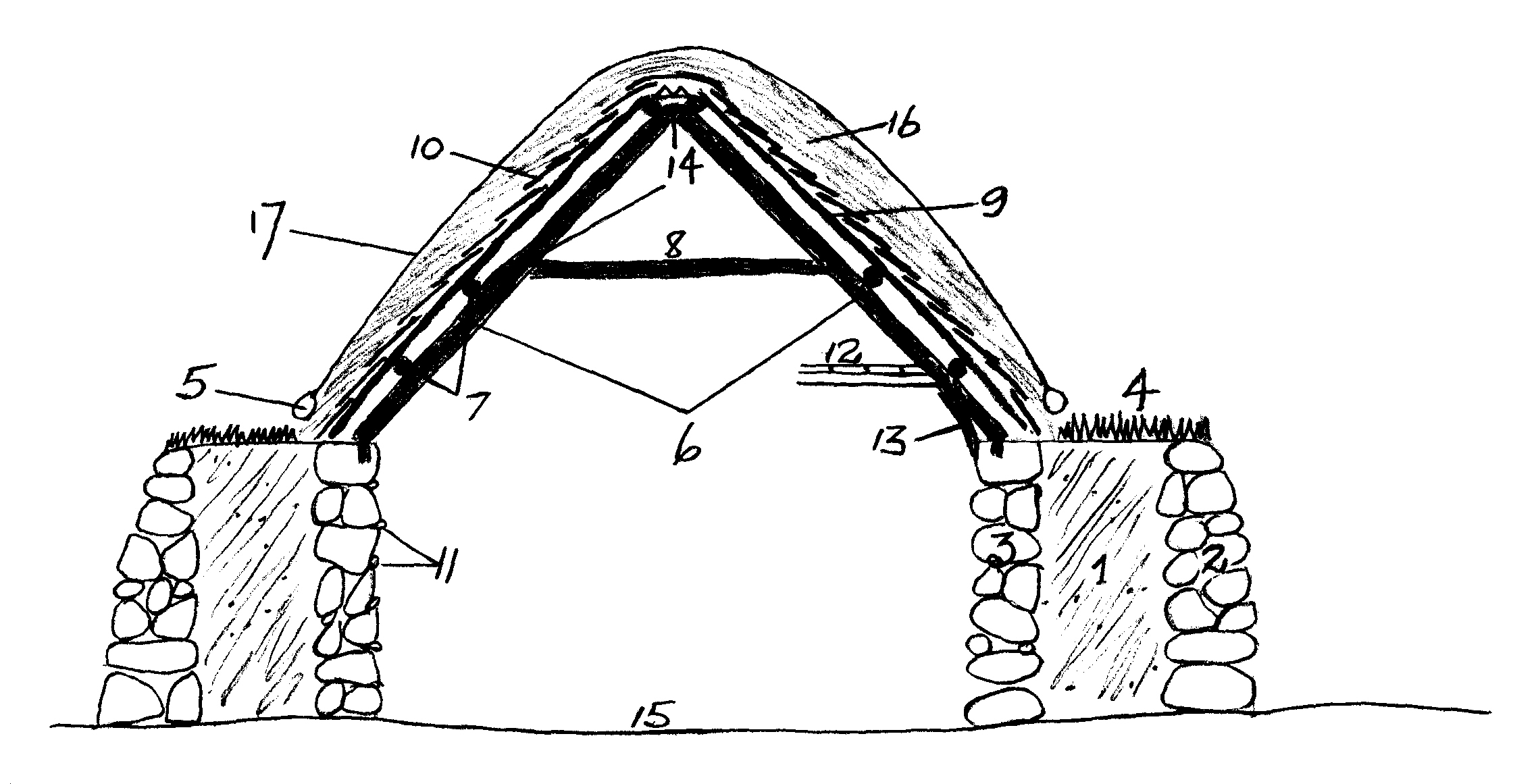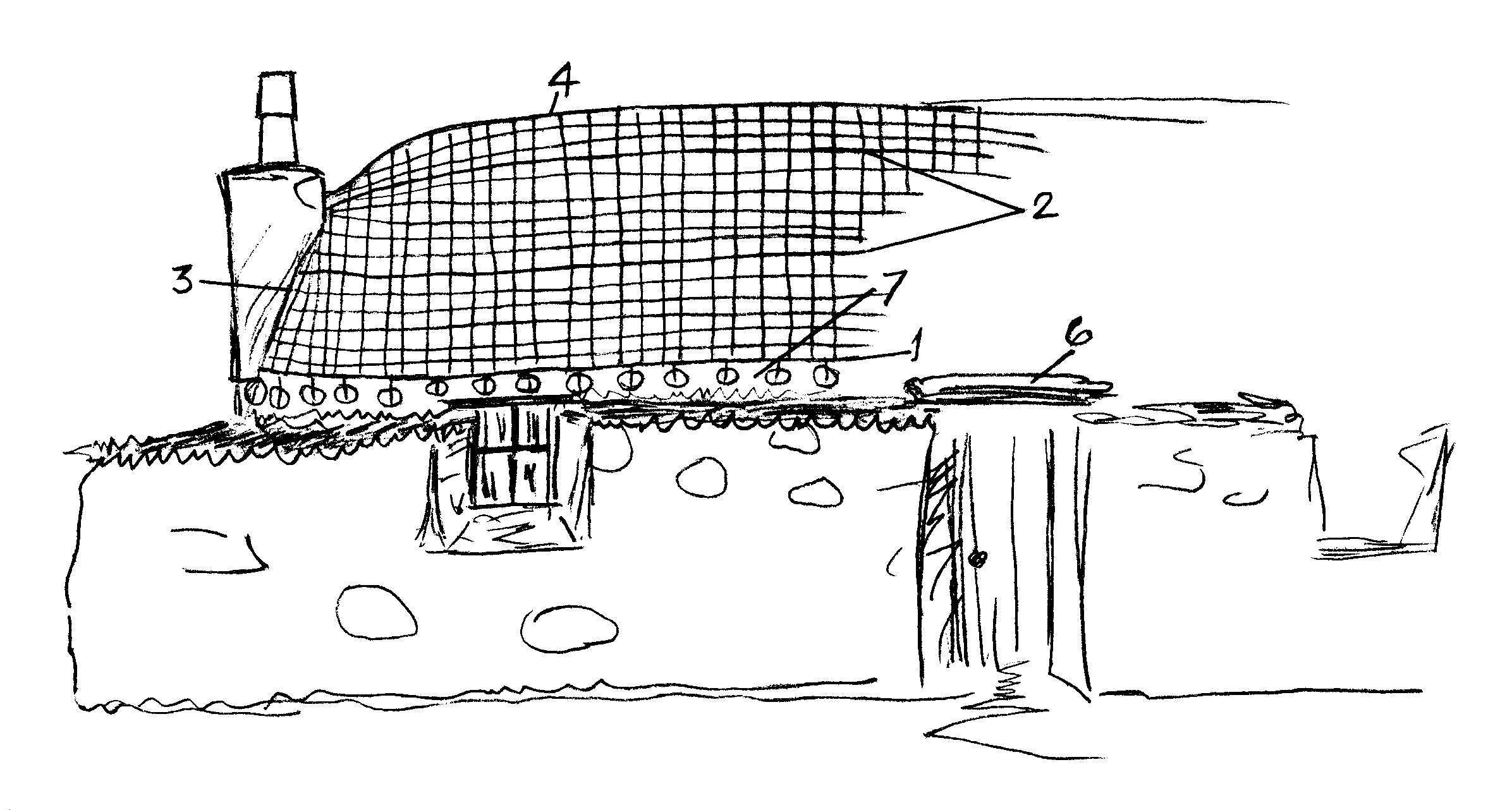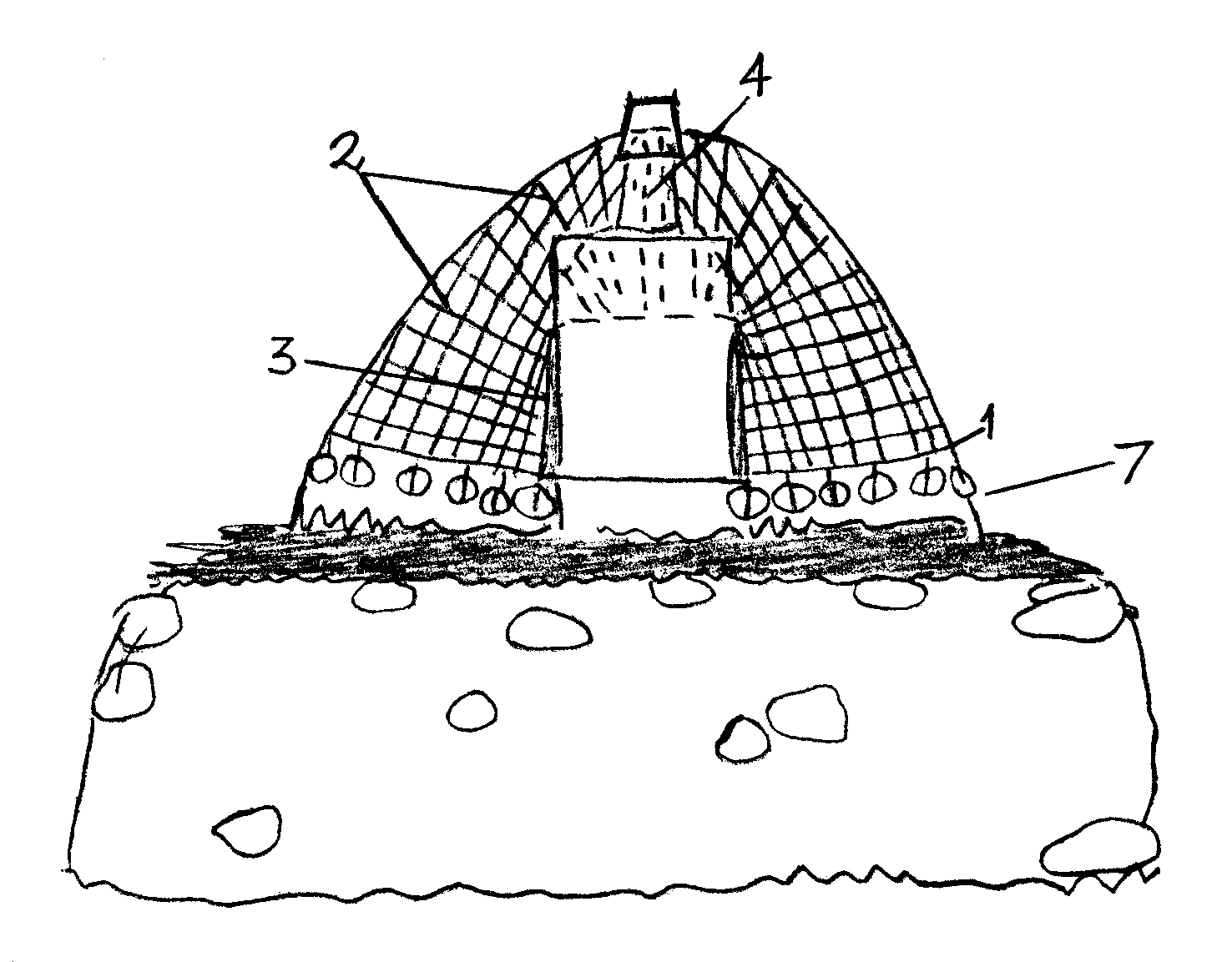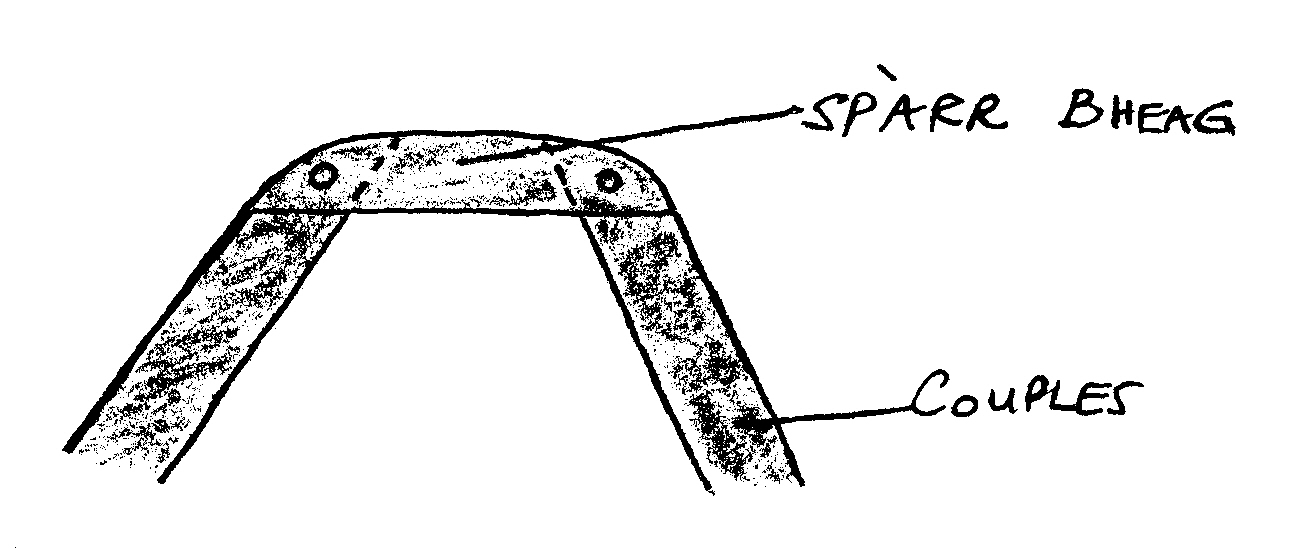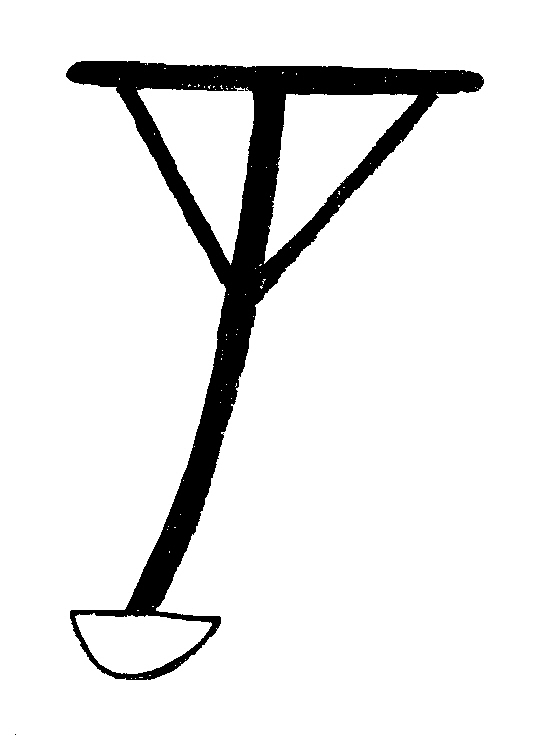| Old Tiree house | 1. Gluta (dh). 2. Am balla-mach. 3. Am balla-staigh. 4. Tobhta. 5. Na buadhan. 6. (Na) Ceann a’ mhaidean. 7. Na taobhan (àrd is ìseal). 8. Sparr tharsainn. 9. Na cabair. 10. Sgrothan. 11. Spallachan. 12. Lobhta. 13. Am balla beag. 14. Cranndairean. 15. Ùrlar dubh. 16. Tughadh. 17. Sìoman ruadh. [NOTES: see below for definitions.]Note: no ridge pole in Tiree houses, which gives rise to a rounder ridge. |
| 1. Gluta (dh) | Rarely, if ever, does this word have a ‘g’ sound at the end. [NOTE: see the illustration under ‘Old Tiree house’.] |
| 2. Am balla-mach | The word ‘muigh’ is never used in Tiree. [NOTE: see the illustration under ‘Old Tiree house’.] |
| 3. Am balla-staigh | [NOTE: see the illustration under ‘Old Tiree house’.] |
| 4. Tobhta | [NOTE: see the illustration under ‘Old Tiree house’.] |
| 5. Na buadhan | This is always the word used in Tiree for anchor stones. Never ‘acraichean’ as is the usual in most places. [NOTE: see the illustration under ‘Old Tiree house’.] |
| 6. (Na) Ceann a’ mhaidean | Couples. [NOTE: see the illustration under ‘Old Tiree house’.] |
| 7. Na taobhan (àrd is ìseal) | Sometimes there are three purlins on each side of the roof instead of just two. [NOTE: see the illustration under ‘Old Tiree house’.] |
| 8. Sparr tharsainn | [NOTE: see the illustration under ‘Old Tiree house’.] |
| 9. Na cabair | [NOTE: see the illustration under ‘Old Tiree house’.] |
| 10. Sgrothan | As opposed to ‘sgrathan’. [NOTE: see the illustration under ‘Old Tiree house’.] |
| 11. Spallachan | Small wedge stones in wall. [NOTE: see the illustration under ‘Old Tiree house’.] |
| 12. Lobhta | Ceiling. [NOTE: see the illustration under ‘Old Tiree house’.] |
| 13. Am balla beag | Usually made of lime from maoraich mixed with dung and mud; connecting the top of the inner wall with the ceiling to exclude the house interior from draughts. [NOTE: see the illustration under ‘Old Tiree house’.] |
| 14. Cranndairean | Octagonal wooden pins. [NOTE: see the illustration under ‘Old Tiree house’.] |
| 15. Ùrlar dubh | Made from a mixture of clay and sand with sheep’s urine. The ‘ùrlar’ tended if anything to be slightly lower than the level of the ground outside. [NOTE: see the illustration under ‘Old Tiree house’.] |
| 16. Tughadh | Note: a thatched house in Tiree is called ‘tigh tughadh’ and not ‘tigh tughaidh’ as is customary in some other places. [NOTE: see the illustration under ‘Old Tiree house’.] |
| 17. Sìoman ruadh | Coir stack rope. [NOTE: see the illustration under ‘Old Tiree house’.] |
| 17. Sìoman càmhlaich | Word used in Tiree for straw-rope. [NOTE: see the illustration under ‘Old Tiree house’.] |
| Some ropework terms | 1. Am mathair-shioman. 2. Na criosan. 3. Sioman gualainn. 4. An sioman dróma. 6. An t-àrd doras. 7. Bùna-baca. [NOTES: see below for definitions.] |
| Ropework at hip with chimney | 1. Am mathair-shioman. 2. Na criosan. 3. Sioman gualainn. 4. An sioman dróma. 7. Bùna-baca. [NOTES: see below for definitions.] |
| Ropework at hip without chimney | 1. Am mathair-shioman. 2. Na criosan. 4. An sioman dróma. 5. Na lùban. 7. Bùna-baca. [NOTES: see below for definitions.] |
| 1. Am mathair-shioman | [NOTES: see the illustrations under ‘Some ropework terms’, ‘Ropework at hip with chimney’ and ‘Ropework at hip without chimney’.] |
| 2. Na criosan | About every sixth horizontal rope had a rope twisted round it after the vertical ones were in place on top of them, so as to keep the vertical ones equally spaced from one another. [NOTES: see the illustrations under ‘Some ropework terms’, ‘Ropework at hip with chimney’ and ‘Ropework at hip without chimney’.] |
| 3. Sioman gualainn | Rope going round chimney and weighted down at both ends by extra large anchor stones. [NOTES: see the illustrations under ‘Some ropework terms’ and ‘Ropework at hip with chimney’.] |
| 4. An sioman dróma | This rope was usually double and went longitudinally from one hip-end to the other. It was always the first rope to be laid on the roof as all the horizontal ropes (except ones at a chimney which are made fast to the ‘sioman guallain’ [sic]) were made fast to it as also were the hip vertical ropes which were passed through loops on it. [NOTES: see the illustrations under ‘Some ropework terms’, ‘Ropework at hip with chimney’ and ‘Ropework at hip without chimney’.] |
| 5. Na lùban | Loops formed by a length of rope tied at the top of the hip to the ‘sioman dróma’ [q.v.], through which the hip vertical ropes passed. [NOTES: see the illustration under ‘Ropework at hip without chimney’.] |
| 6. An t-àrd doras | [NOTES: see the illustration under ‘Some ropework terms’.] |
| 7. Bùna-baca | (‘Bonnacha-bac’ in Dwelly’s.) If draughts were entering the house or rain was getting in at this low part of the roof then sacks of sand were sometimes placed at the ‘bùna-baca’. [NOTES: see the illustrations under ‘Some ropework terms’, ‘Ropework at hip with chimney’ and ‘Ropework at hip without chimney’.] |
| [spàrr bheag] | The old felt-roofed houses of Tiree also had a flatly rounded ridge, made by connecting the couples by means of a piece of wood known as ‘an spàrr bheag’. |
| [lair-chaib’] | In Dwelly’s this turfing spade (for houses roofs and potato pits) is called ‘caibe làir’, but in Tiree it is always known the other way round – ‘lair-chaib’’. |
| [caitcheann] | Dwelly says that ‘caitcheann’ is “Land common to all the crofters in a township – Tiree.” The only way I have heard it pronounced in Tiree is ‘càiteanan’. |

